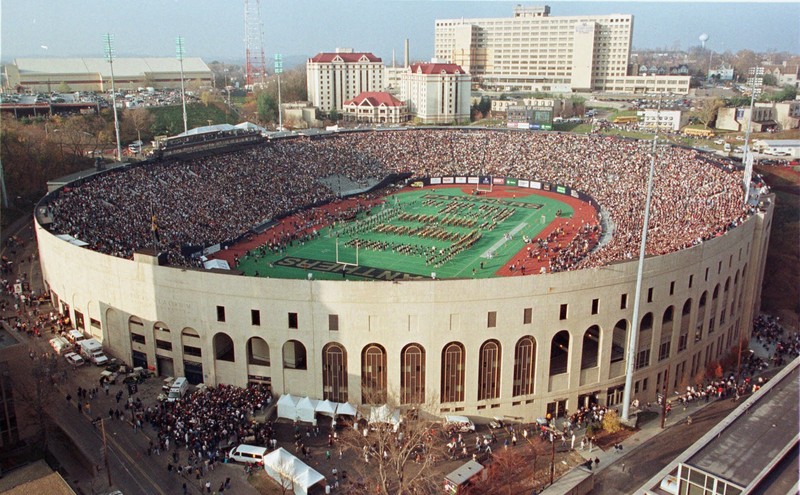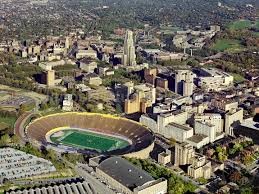Pitt Stadium, 1925-1999
Introduction
Text-to-speech Audio
This is the former location of Pitt Stadium, home to the University of Pittsburgh football stadium from 1925 until the end of the 1999 season. In addition to housing the Pittsburgh Panther's, this stadium was a second home for the Pittsburgh Steelers from 1958 to 1963, and the full-time home from 1964 until 1970 when the team moved to Three Rivers Stadium. The Carnegie Tech Titans shares the field with the Panthers from 1929 until 1943.
Images
Pitt Stadium once stood where the Petersen Events Center is now located

The Pittsburgh Panthers played their home games at this stadium from 1925 to 1999.

Backstory and Context
Text-to-speech Audio
During the 1910s and early 1920s the University of Pittsburgh's football program became one of the premier college programs, with several undefeated seasons and championships. During this time, the Panthers played their home game at Forbes Field, the home of the Pittsburgh Pirates. Due to the success of the program, and the increasing popularity of college football, Forbes Field was unable to accommodate the growing crowds. For this reason, the university administration decided to build this large stadiu on their campus.
Construction for Pitt Stadium began on August 7, 1924 and was completed on September 1, 1925. The first game was played on September 26, 1925 with Pittsburgh defeating Washington and Lee 26 to 0. In 1970, the stadium's natural grass surface was covered with astroturf was installed. In 1984, a new substance called "Superturf" was installed, but this field proved less than worthy of its superlative and the team returned to astroturf six months later. Although most collegiate programs switched back to grass, the Panthers played on astroturf until the demolition of the stadium.
There were many changes to the stadium over the years beyond the changes made to the playing surface. Due to safety concerns, bleacher seats were removed from the rim of the stadium in the 1940s. The original seats were only sixteen inches wide and replaced with larger 18 inch-wide seats to increase comfort and accommodate larger fans. These changes reduced the capacity of the stadium to 56,500.
In the 1970s, the original wooden bleachers were replaced with metal bleachers-a change that required 17 miles of bleachers. The 1985 season saw the addition of temporary lighting and 1987 saw the conversion to a fixed lighting system that became a permanent part of the field. The first electronic scoreboard was installed in 1995, replaced later by the then-state-of-the-art PantherVision videoboard in 1997.
Rather than continue to renovate the historic stadium, the administration reached a deal with the Pittsburgh Steelers that permitted the university to use Three Rivers Stadium. The last game in Pitt Stadium was played on November 13, 1999 in which they defeated Notre Dame 37-27. Following this final game, the stadium was demolished and the Panthers moved to Three Rivers Stadium, and later Heinz Field. Although some alumni and students have been hopeful that the university will build a new on-campus stadium, university leaders oppose such a measure for a variety of reasons in addition to its cost.
Construction for Pitt Stadium began on August 7, 1924 and was completed on September 1, 1925. The first game was played on September 26, 1925 with Pittsburgh defeating Washington and Lee 26 to 0. In 1970, the stadium's natural grass surface was covered with astroturf was installed. In 1984, a new substance called "Superturf" was installed, but this field proved less than worthy of its superlative and the team returned to astroturf six months later. Although most collegiate programs switched back to grass, the Panthers played on astroturf until the demolition of the stadium.
There were many changes to the stadium over the years beyond the changes made to the playing surface. Due to safety concerns, bleacher seats were removed from the rim of the stadium in the 1940s. The original seats were only sixteen inches wide and replaced with larger 18 inch-wide seats to increase comfort and accommodate larger fans. These changes reduced the capacity of the stadium to 56,500.
In the 1970s, the original wooden bleachers were replaced with metal bleachers-a change that required 17 miles of bleachers. The 1985 season saw the addition of temporary lighting and 1987 saw the conversion to a fixed lighting system that became a permanent part of the field. The first electronic scoreboard was installed in 1995, replaced later by the then-state-of-the-art PantherVision videoboard in 1997.
Rather than continue to renovate the historic stadium, the administration reached a deal with the Pittsburgh Steelers that permitted the university to use Three Rivers Stadium. The last game in Pitt Stadium was played on November 13, 1999 in which they defeated Notre Dame 37-27. Following this final game, the stadium was demolished and the Panthers moved to Three Rivers Stadium, and later Heinz Field. Although some alumni and students have been hopeful that the university will build a new on-campus stadium, university leaders oppose such a measure for a variety of reasons in addition to its cost.
Sources
Pitt Stadium Facts. (n.d.). Retrieved May, 2016, from http://www.pitt.edu/~elarson/stadium.html
Pitt Stadium. (n.d.). Retrieved May, 2016, from https://en.wikipedia.org/wiki/Pitt_Stadium
